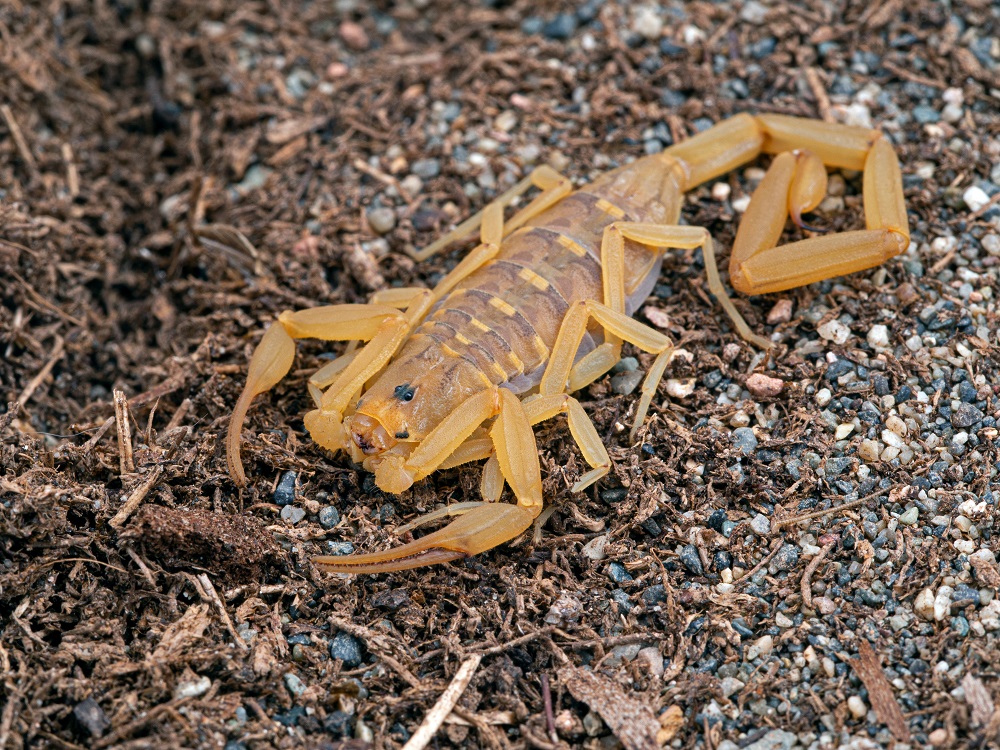Scorpions may seem larger than life, but most aren’t more than a few inches long! Arizona is home to one of the largest scorpion species, the giant desert hairy scorpion, which measures over 5 inches long.
The Sonoran Desert also houses the most venomous scorpion species in the United States: the Arizona Bark Scorpion. An Arizona bark scorpion’s size doesn’t match their larger neighbors, but they’re still a significant problem for many homeowners across the state.
These pests seem frightening despite their small stature, but you have nothing to fear with Scorpion Repel! Contact us today to learn more about our services!
Scorpions in the United States
What other scorpions compare to the Arizona bark scorpion’s size? There are around 90 scorpion species throughout the country, with most populating desert regions in the southwest.
These pests can range from a few centimeters long to a couple of inches in length. Regardless of their size, all scorpions have similar characteristics. Like most arachnids, scorpions have eight legs and two large pinchers.
Another component of a scorpion is its tail and stinger. Every scorpion species has venom stored in their sharp needle-like stinger, but only a few scorpions are dangerous.
Arizona Bark Scorpion Size
The Arizona bark scorpion is the most venomous species in the United States. Primarily located in Arizona and other desert regions, these pests can cause trouble for homeowners whenever they sneak indoors.
The Arizona bark scorpion is a tiny adversary for Arizona residents. This pest only measures in at around three inches in length, paling in comparison to other scorpions across the country.
However, their small stature can easily make them troublesome houseguests! While Arizona stays warm year-round, the state can experience frigid temperatures during cold fall and winter nights.
Scorpions generally prefer the heat and look for areas to hibernate whenever the average temperature dips below 60 degrees at night.
In the wild, Arizona bark scorpions may choose to burrow underground, around rocks, inside brush piles, or head indoors to spend the winter in residential or commercial areas.
According to the Arizona Department of Agriculture, this pest is the most common species found indoors. The Arizona bark scorpion’s size allows it to covertly squeeze through small gaps and spaces around your home– spots you may not even notice.
They can sneak inside through a gap the width of a credit card and easily climb interior and exterior walls to find the perfect entry point.
Here are some common ways Arizona bark scorpions can come inside:
- Gaps in doors and windows
- Improperly caulked areas
- Cracks on the exterior of your home
- Unseen crevices
Because of their small size, an Arizona bark scorpion could even waltz in an open door or window to find reprieve during the fall and winter seasons.
Arizona Bark Scorpion Size vs. Yellow Ground Scorpion Size
In Arizona, another species resembles the Arizona bark scorpion and is even similar in size. The yellow ground scorpion looks strikingly like Arizona’s resident troublemaker and can be challenging to tell apart at a glance.
Both scorpions are comparable lengths and even share nearly identical colorations. You may mistake a yellow ground scorpion for its highly venomous counterpart!
The yellow ground scorpion has one defining characteristic that sets it apart from an Arizona bark scorpion. Besides their generally harmless venom, yellow ground scorpions have bulkier and shorter tails.
However, you may not want to get close to a scorpion to discern what pest is in your home! To keep scorpions out of your home and prevent a problem before it begins, contact Scorpion Repel for our patented scorpion repelling treatment!
Other Bark Scorpions Compared to the Arizona Bark Scorpion Size
While the striped bark scorpion’s appearance doesn’t mirror an Arizona bark scorpion, the two species share a similar name!
The striped bark scorpion is known for its large brown stripes that extend down the length of its body. Arizona bark scorpions are much lighter in color and lack the other species’ signature markings.
Surprisingly, an Arizona bark scorpion’s size is comparable to striped bark scorpions. While most male Arizona bark scorpions can measure over three inches in length, female Arizona bark scorpions are typically as long as striped bark scorpions, each around 2 ¾ inches long.
Unlike the yellow ground scorpion, it isn’t likely you’ll mix these two species up. Besides their distinct appearances, the two scorpions primarily inhabit different areas. While the striped bark scorpion lives in Mexico, New Mexico, and Texas, their populations are limited to only a section of Arizona.
Preventing Arizona Bark Scorpions in My Home
Because of their potent venom, no one wants Arizona bark scorpions sneaking indoors! A scorpion sting can hurt and have nasty side effects you’ll want to avoid.
Here are some tips to keep Arizona bark scorpions out of your home:
- Seal up exterior cracks and crevices
- Repair any home damage
- Properly seal your windows and doors
- Replace any damaged or deteriorated caulking
- Clear brush piles or limbs in your yard
Eliminating their access points can prevent Arizona bark scorpions from crawling indoors, but you could still struggle with these pests finding a way inside.
An Arizona bark scorpion’s size allows them to squeeze in through the smallest of spaces, so you may accidentally neglect to fill in unnoticed gaps.
Here, at Scorpion Repel, our patented product creates a barrier around your home that prevents these pests from crawling up the exterior of your residence. As they try to climb inside, our proven product keeps them out! Check out our treatment at work here!
Whenever you have scorpions invading your home, contact us to keep your home scorpion-free!

